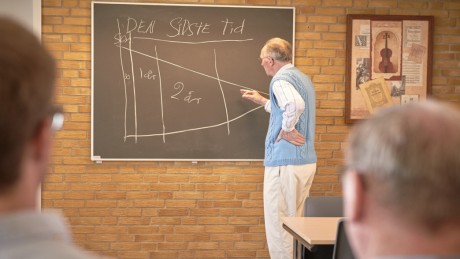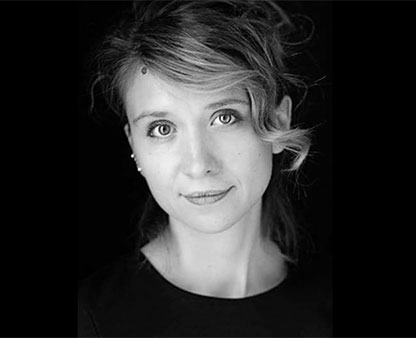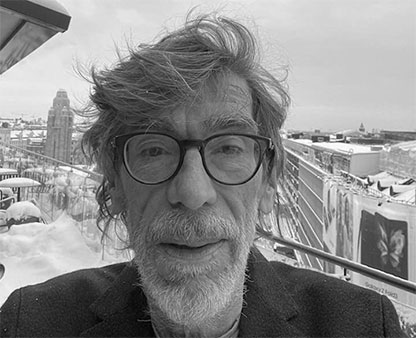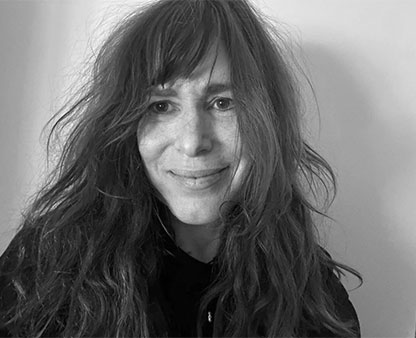Hans Lauridsen sidder i nervøs venten. Han har inviteret til foredrag i et forsamlingshus i Ribe. To timer med pause. Han vil fortælle om alle de tegn i tiden nu, som viser hen mod, at den sidste tid, at dommedag er nær. Man sidder på det her sted i filmen i nervøs venten med ham, der kommer da ikke nogen til det foredrag? Man har jo fulgt forberedelserne, rystet lidt på hovedet af hans plan, ingen går da til foredrag om sådan noget uden foredragsholderen er et navn.
Men jeg tager fejl, tager fejl af den særlige styrke i foredraget som form, tager fejl af styrken i den særlige ældre folkelighed, tager fejl af Ribe og foredragskulturen der. Og måske er Hans Lauridsen og hans kone Ester navne der i byen, selv om de, som de har fortalt tidligere i deres optagethed af deres oplysningskampagne med at forberede menneskene på Jordens undergang, har mistet næsten alle deres venner.
Imidlertid er foredraget omhyggeligt forberedt, det har Christoffer Dreyers film film gjort mig til vidne på. Og lidt efter lidt kommer folk, hjemmevante foredragsbrugere, lyttende og interesserede og spørgende ind til detaljer og Hans Lauridsen svarer og de nikker og accepterer det han siger og de accepterer ham og de vil komme igen hvis han vil lave en fortsættelse.
Christoffer Dreyer har tidligere lavet en film om byen Gedsers diskrete kultur (En detektiv i provinsen, 2012), han er opmærksom på detaljerne sådanne steder, og som foredraget er omhyggeligt tilrettelagt, er hans film omhyggeligt konstrueret i enhver detalje. Hans arbejde er respektfuldt inspireret og påvirket af de to medvirkendes velordnede research og formidling, ligesom han også ved venlige og diskrete referencer vedkender sig sin afhængighed af filmhistoriens og filmæstetikkens arv, her især oplagt i Jon Bang Carlsens vestjyske landskab, sprog og tanke. Hans og Esther Lauridsens tillid til Gud er skildret grundfæstet som Jennys er det i Bang Carlsens film: ”Det er fredag den anden januar 1977, og jeg føler mig sund og rask… Der er sket meget i min tid…” Og Jenny sammenligner sit liv med den nye usikkerhed. Hun er i det moderne: ”I et kontrolrum et sted i USA, har jeg læst, er der altid to til stede. Hvis den ene skulle bryde sammen og ville trykke på knappen, skal den anden kunne gribe ind. Sådan også på Cheminova, vores kemifabrik. Der er der også to, skulle den ene falde i søvn. For mennesket må selv tage ansvar og ikke give Gud skylden for ulykkerne, det selv har skabt grundlaget for.”
Ingmar Bergmans fisker Jonas Persson i Nadvergæsterne (1961) kan i sin paniske angst ikke selv tale om den. Fru Persson må gøre det, hun opsøger præsten i sakristiet i kirken og siger under samtalen: ”Det begyndte i foråret. Jonas havde læst i en avis om kineserne… Der stod i den artikel, at det er et spørgsmål om tid, hvornår kineserne har atombomben. De har ingenting at tabe. Sådan stod der. Jeg er ikke bange. Det er vel bare, fordi jeg ikke har så meget fantasi. Men Jonas tænker altid. Og vi vender og drejer det. Selv om jeg ikke kan være til så megen hjælp…”
Tilsvarende kæmper Hans og Ester Lauridsen med en angst, men hvad fiskeren ikke kan og præsten slet ikke hjælpe ham med, det kan de to. De tager opgaven på sig. Ved bøn ja, men derefter bestemt også ved nøje gennemtænkte handlinger. De forbereder sig, og når de viser vær-beredt-rygsækkene med alt både simpelt og sindrigt overlevelsesudstyr frem, er de for mig at se tillige tydeligt i slægt med en bestemt af de eventyrligt rejsende tænkere af den praktiske fremskredne sekulære vildmarksskole, som Werner Herzog møder ved verdens ende i Antarktis og får hans flugt-rygsæks indhold bredt ud for kameraet.
Endelig da Esther og Hans sidder i deres hus i Ribe under århundredets storm i december 2013, filmer Christoffer Dreyer i en vidunderligt fint distanceret scene Hans’ målbevidste arbejde med at afstive sit stakit omkring parcellen som var det Don Quijotes kamp mod vejrmøllerne, og instruktøren får med denne blide reference til verdenslitteraturen sin film forbundet med menneskets universielle angsthåndteringer al tid.
Dreyer begynder sin film midt i en optagelse med Esther bag kameraet, en optagelse af Hans’ foredrag til en af deres talrige film om den sidste tid, hvor han på YouTube fremlægger sine og Esthers bibelstudier sammenholdt med klimasituationen og vist nok også andre trusler mod livet på kloden. Man får aldrig rigtigt indblik i det, for det er selvfølgelig ikke Dreyers ærinde, selv om hans film og deres film har samme titel. Dreyer skildrer stilsikkert deres filmoptagelse som alvorligt dilettant i forsamlingshuset. Hans Lauridsen overspiller i nervøs iver sin rolle ubehageligt, men kort efter afløses den instruerede scene af interview som voiceover til billedet og det dæmper det opskruede, og når interviewets billede klippes med, begynder man at lære Hans og Esther at kende som stilfærdige og ganske almindeligt ræsonnerende i deres engagement.
Deres åndelige baggrund antydes ved et besøg på galleri i indre missionsk regi for religiøs kunst, men det slås i dialogen udtrykkeligt fast at de to ikke tilhører noget trossamfund. Imidlertid bliver de ved forslag fra tilhørerne ved foredraget fristet af tanken om en lille menighed. Og snart er en bibellæsekreds i gang i deres stue.
Men Dreyer og hans klippere sætter nu stille og roligt en anden og en tredje udvikling ind i fortællingen. Først er der Esters helbred, hendes dårlige ryg og polio senvirkningerne, så ser man at Hans bruger kontorstol ved køkkenbordet, han har for lavt blodtryk og svimmelhedsanfald. Han klarer dog alene foredrag nummer to, Esther må blive hjemme, men han gennemfører og sikrer endnu en succes. Dernæst er der deres kærligheds udvikling i ømhed så diskret fortalt som i en kort fin scene uden dialog, kun musikken og lyddesignet så omhyggeligt som resten i konstruktionen.
De havde planlagt deres guldbryllup, men de må aflyse gildet, og den i filmens forløb efterhånden ganske afdæmpede og på anden måde indsigtsfuldt afklarede Hans indser filmtitlens dobbelthed, de to slags afslutninger, to sæt sidste tider. Det lave blodtryk, de fire indlæggelser på en måned, Ester alene hjemme begynder i interviewet at tale om Hans i datid. Men guldbryllup for de to bliver det dog til derude ved havet.
Det bedste ved Christoffer Dreyers film er genkendeligheden, dens aldeles indforståede iagttagelse af de to ægtefæller, deres liv og tanker, deres arbejde i mange detaljer, deres kærlighed i sarte nuancer og så først og fremmest en sjælden, men selvfølgelig og naturlig ægte empati uden nysgerrighed og med ligeværdighed i sagkundskab: Esther og Hans, I laver filmens åbning, jeg og holdet laver så resten sammen med jer, vi fordeler rollerne mellem os, den her film er holdarbejde, Den sidste tid er en sikkert gennemført filmovervejelse af enhvers tanker om afslutningen. Afslutningen for sig selv, afslutningen for vores kultur.
Christoffer Dreyer: Den sidste tid, Danmark 2016, 73 min. Premiere for DOXBIO i en række biografer 16. november:
http://www.doxbio.dk/kob-billet/ (biografer og tidspunkter)
http://www.doxbio.dk/movie-archive/den-sidste-tid/ (om filmen)
SYNOPSIS
Esther og Hans elsker livet og hinanden. De har tilbragt næsten hver en vågen time sammen og som mange andre ægtepar, glæder de sig til deres guldbryllup. Det særlige er, at lige netop dette par samtidig håber, at de aldrig kommer til at opleve det. Esther og Hans er nemlig danske ”preppers” og forbereder sig på dommedag med lige dele frygt og længsel. Siden 1972 har de brugt al disponibel tid på at studere biblen i forhold til begivenheder, der er sket i verden omkring dem – og svaret er entydigt: Jorden kan gå under hvert øjeblik, det skal være. De har rygsækken pakket og klar, så de kan overleve i de svenske skove, når ragnarok kommer, men nu har de ventet i 40 år, og da Hans bliver alvorligt syg, må de se i øjnene, at det ikke er jordens sidste tid, de står overfor, men deres egen. (Filmens pressemateriale)
CREDITS
Foto: Christoffer Dreyer og Matthias Nyholm Schmidt. Medvirkende: Esther og Hans Lauridsen. Klip: Christian Einshøj, Thomas Papapenos og Morten Giese samt Pernille Bech som konsulent. Illustration: Kristian Eskild Jensen og Simon Bang. Musik: Martin Pedersen. Produktion: Jesper Jack, House of Real.





